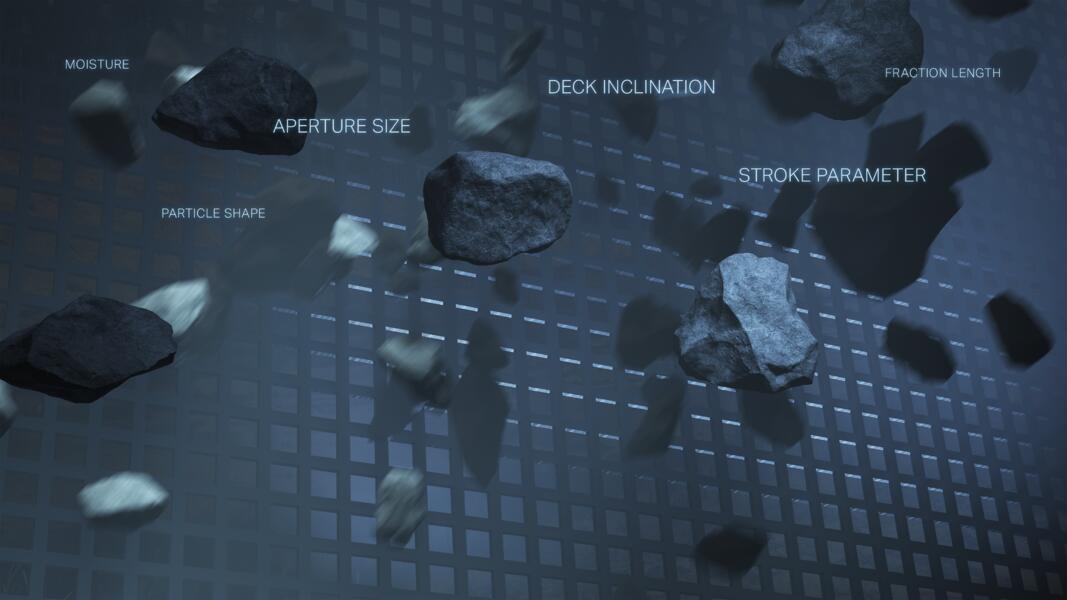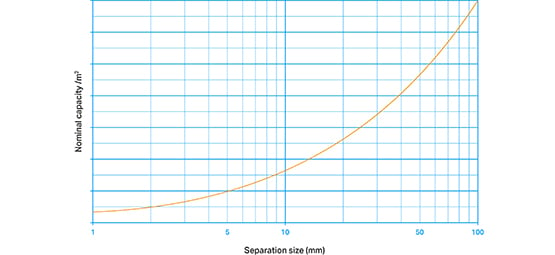Choosing the right screening area

Getting the right screen size is important. If the screen is too small then you will end up with excessive undersize particles in the overflow. But it’s also possible to have a screen that’s too big. Larger screens mean thinner material beds, and that can cause particles to bounce over the deck without falling through an aperture. The result can be the same – excess undersize in the overflow. Maximizing the efficiency of a screening operation, then, depends on getting the screen as close to the optimal size as you can.
It’s possible to do a quick estimate of the optimal screen size, based on pre-calculated values. This is a somewhat old-fashioned approach, seeing as it doesn’t rely on computer-based calculations or detailed analysis. It often ends up delivering fairly efficient results, but it can also lead to wild inaccuracies because it’s based on a lot of assumptions.
In most cases, then, it’s worth making a more complete analysis.
Across the industry, you’ll find a number of different techniques and formulas for calculating optimal screen size, most of which are based around establishing the throughput capacity (in tons per hour per m2) for the specific operation.
This is a general approach that we endorse at Sandvik. Our calculation of optimal screen size, however, differs from many other analyses in the level of detail we apply. Our experts make a very detailed analysis which takes several variables into account. The factors we investigate include:
- Nominal capacity for separation
- Oversize factor
- Half size factor
- Type of material
- Bulk density
- Moisture
- Type of screen
- Wet or dry screening
- Deck position
- Screening element
- Fraction length
- Accuracy demands
Here’s a brief description of these factors, and an explanation of how they affect optimal screen size.
Nominal capacity for separation
You can think of the nominal capacity for separation as the starting point for calculating the screen area – we then apply the variables that are specific to your operation.
It describes the theoretical throughput of a screen per square meter, for a specific separation size. It’s important to realize that the throughput changes according to the size of the material that you are screening – larger stones and larger holes have a greater throughput capacity, all other things being equal. This is because the effect of gravity (which pulls the stones through the screen) increases more than the effect of friction (which offers resistance to stones moving through the screen) as the particle size increases.
You would normally establish the nominal capacity using a chart similar to the one below. You can see how capacity increases with separation size.

Oversize factor
This is the percentage of particles in the feed that are larger than the separation size. Feed with a higher percentage of oversize particles will require a bigger screen – the larger particles block smaller particles from moving through the bed.
Half size factor
Feed with a high proportion of particles that are significantly smaller than the separation size can be screened quicker, since smaller particles pass more easily through the bed and screen. The half size factor depends on the percentage of particles in the throughput material that are 50% smaller than the desired separation. The higher the percentage, the smaller the optimal screen size.
Type of material
The feed material can have a lot of characteristics that affect how easy it is to screen, and thus influence the size of screen required. These include surface smoothness and the flakiness of the material.
Bulk density
One might expect denser material to be easier to screen, and this is true – up to a point. Sandvik’s years of practical experience have taught us that material with a high bulk density (over 2.5 metric tons per cubic meter) is often harder to screen, and thus requires a larger screen size.
Moisture
The amount of moisture in the feed material is significant. Moister material is harder to separate but this relationship isn’t linear. Smaller fractions have a greater surface area to mass ratio, so moisture will be a more significant factor when you are working with fines.
Type of screen
Different screen types and inclinations will have different effects on both stratification and separation probability.
Wet or dry screening
Washing generally helps particles flow through the screen, an effect that is more pronounced with smaller stones. The type of washing is also significant, so the Sandvik formula for calculating screen size takes a number of additional factors into account, like water volume and pressure, the type of nozzle that’s used, and where on the deck water is added.
Deck position
Material reaches lower decks later, of course, so it’s important to take the deck position into account when calculating screen size.
Screening element
The screening media can have a significant impact on the optimal size. Different materials produce different amounts of friction and blinding, and you also need to consider its thickness, it’s efficient open area percentage, and the shape and pattern of the apertures. The condition of the screen is also important. If the screen is worn down or damaged, this will have an impact on its effectiveness. At Sandvik, we consider the wear life and long-term performance of screening media when we calculate optimal size.
Fraction length
Material with a longer fraction – that is, with a larger relative difference between the smallest and biggest particles in the overflow material – is easier to separate, all other things being equal.
Accuracy demands
To find the optimal screen size, it’s good to have a firm idea of what constitutes an acceptable amount of misplaced particles – bearing in mind that 100% effectiveness is not practically possible. The industry standard assumption is that 10% oversize particles in the underflow, and 15% undersize particles in the overflow is a reasonable starting point. This ratio is also the basic assumption of misplaced particle amount in typical fraction standards. From there, we calculate the screen size according to whether your demands are more or less stringent. We believe this is a more effective way to calculate throughput capacity (and screen size) then the ‘screening efficiency’ factor that you may have seen in similar calculations elsewhere.